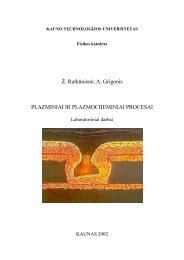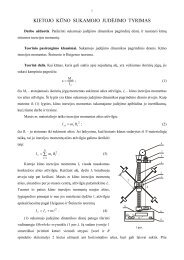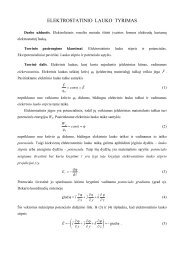PROCEEDINGS OF THE 7 INTERNATIONAL ... - Fizika
PROCEEDINGS OF THE 7 INTERNATIONAL ... - Fizika
PROCEEDINGS OF THE 7 INTERNATIONAL ... - Fizika
You also want an ePaper? Increase the reach of your titles
YUMPU automatically turns print PDFs into web optimized ePapers that Google loves.
2.3. Biological test.<br />
Y. Dekhtyar et al. / Medical Physics in the Baltic States 7 (2009) 69 - 71<br />
To verify the UV influence on chemical couples<br />
behaviour at the surface of PMMA, non-irradiated and<br />
irradiated samples were compared. On both yeast<br />
cultivation sacharomyces cerevisiac 14 was deposited<br />
and left for 4 days. Then the dried and coloured cells<br />
showing differently living and dead cells were counted<br />
with Olympus CX31 microscope and results compared<br />
(Fig.4).<br />
3. Results<br />
UV radiation increased the contact angle, i.e. wettability<br />
of the PMMA became worse in the exposure range until<br />
90 minutes, however was directed to the native<br />
condition at 160 minutes (Fig. 1) This could be<br />
connected with deposition of the electrical charge since<br />
the electron work function increases and positively<br />
correlates to the contact angle at least in the range until<br />
90 minutes of exposure (Fig. 2). The increase of the<br />
work function value evidences that the surface acquired<br />
the negative charge. Because of the UV radiation could<br />
induce photoemission electrons should leave the<br />
specimen, the latter inducing the positive charge of the<br />
PMMA surface. However the experiment demonstrated<br />
the reversible result. This could be explained that UV<br />
reconstructed chemical couples of PMMA. The charged<br />
surface relaxed during 2-2.5 months (Fig. 3). The<br />
biological test demonstrated that yeast cell viability on<br />
the radiated surface falls down (Fig 4).<br />
4. Conclusions.<br />
1. UV radiation has a non monotonic influence on the<br />
wettability of the PMMA surface: the surface<br />
changed to the hydrophilic until 90 minutes of<br />
radiation and turned back to the native state, when<br />
the exposure was increased to 160 minutes.<br />
2. Alteration of wettability is probably connected with<br />
reconstruction of chemical PMMA couples.<br />
3. The alteration of PMMA properties induced by UV<br />
radiation decreases viability of the yeast cells<br />
positioned on the PMMA surface.<br />
4<br />
3,5<br />
3<br />
2,5<br />
2<br />
1,5<br />
1<br />
0,5<br />
0<br />
-0,5 0<br />
-1<br />
15 30 45 60 75 90 105 120 135 150 165 180 195<br />
-1,5<br />
Time, min<br />
∆α mean<br />
Fig.1. Contact angle (mean) increment after different<br />
irradiation exposures.<br />
70<br />
α, o<br />
Electron work, eV<br />
Viability, %<br />
80<br />
75<br />
70<br />
65<br />
60<br />
55<br />
50<br />
45<br />
40<br />
0 1 2 3 4<br />
Time, months.<br />
Fig.2. Irradiated 2 h. Mean contact angle dependence from<br />
time.<br />
5,16<br />
5,14<br />
5,12<br />
5,10<br />
5,08<br />
5,06<br />
5,04<br />
5,02<br />
5,0<br />
5,1<br />
5,1<br />
0 15 30 45 60 75 90<br />
Time, min<br />
Fig.3. Electron work dependence on exposure time.<br />
55%<br />
53%<br />
51%<br />
49%<br />
47%<br />
45%<br />
Non-irradiated<br />
Irradiated<br />
Non-irradiated<br />
48%<br />
5,1<br />
54%<br />
Fig.4. Eukaryotic yeast cell viability on PMMA surface.<br />
Irradiated 90min.<br />
5. References.<br />
1. Ratner B.D., Hoffman A.S, Schoen F.J., Lemons<br />
J.E. Biomaterial science. Academic press., New<br />
York, 484, 1996.<br />
2. Dekhtyar Yu., Polyaka N., Sammons R. Electrically<br />
charged hydrohyapatite enhances immobilization<br />
and proliferation of osteoblasts. IFMBE proc.<br />
Springer , 20, 2008. p. 357-360.<br />
3. Ranby J, Rabek JF. Photodegradation, Photooxidation<br />
and Photostabilization of Polymers.<br />
London: John Wiley, 156, 1975.<br />
4. Wunderlich B., Pyda M., Encyclopedia of Polymer<br />
Science and Technology\Vol.12, Thermodynamic<br />
Properties of Polymers, University of Tennessee,<br />
Chemical Sciences Division of Oak Ridge National<br />
Laboratory, 165, 2002.<br />
5. Caykara T., Guven O., UV degradation of<br />
poly(methyl methacrylate) and its<br />
5,1<br />
5,1<br />
5,1








